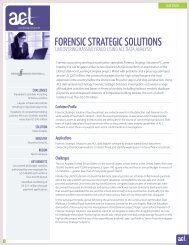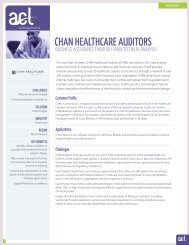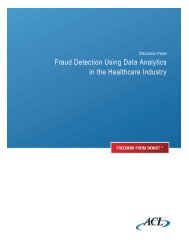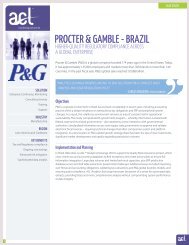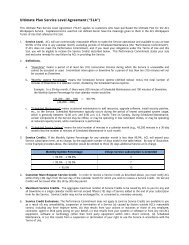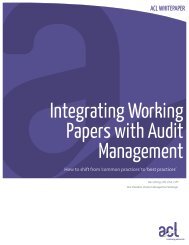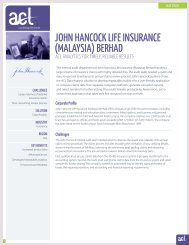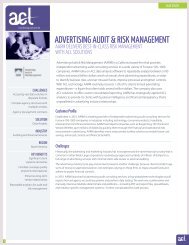ACL Audit Analytic Capability Model - Acl.com
ACL Audit Analytic Capability Model - Acl.com
ACL Audit Analytic Capability Model - Acl.com
You also want an ePaper? Increase the reach of your titles
YUMPU automatically turns print PDFs into web optimized ePapers that Google loves.
WHITE PAPER<br />
The <strong>ACL</strong> <strong>Audit</strong> <strong>Analytic</strong><br />
<strong>Capability</strong> <strong>Model</strong><br />
Navigating the journey from basic analysis to continuous monitoring<br />
“The <strong>ACL</strong> <strong>Audit</strong> <strong>Analytic</strong> <strong>Capability</strong> <strong>Model</strong> provides clear guidance for organizations looking to improve their use of analytics. It’s how<br />
to talk to the business about the value of audit.” | Theodore K. Walter, CPA, Manager, Financial <strong>Audit</strong>s at Scripps Health<br />
Introduction<br />
Today’s business climate is driving an expansion of the role of<br />
internal audit to be more consultative and with a stronger focus on<br />
risk management. Not only is internal audit being asked to be<strong>com</strong>e<br />
more efficient and effective in performing its traditional assurance<br />
role, expectations are heightened to also assess the effectiveness of<br />
risk management processes – a challenge that is amplified by<br />
declining or, at best, flat budgets, increasing <strong>com</strong>plexities around<br />
regulatory <strong>com</strong>pliance and fewer staff.<br />
The case for audit analytics has been made: In 2010, “the use of<br />
automated tools or techniques” by internal audit functions qualified<br />
as a top-five strategic priority according to research from The<br />
Institute of Internal <strong>Audit</strong>ors (The IIA).1 Today, a more practical focus<br />
is taking hold as organizations seek to successfully implement new<br />
audit technology.<br />
For more than 20 years, <strong>ACL</strong> Services, Ltd. has worked closely with<br />
more than 14,700 customer organizations worldwide to develop<br />
market-leading audit analytics solutions. During this time, <strong>ACL</strong> has<br />
collected in-depth intelligence from customers who have enjoyed<br />
great benefits from using audit analytics, as well as valuable<br />
evidence from those who have not.<br />
Based on this knowledge, <strong>ACL</strong> has developed the <strong>Audit</strong> <strong>Analytic</strong><br />
<strong>Capability</strong> <strong>Model</strong>, a framework for assessing different levels of audit<br />
analytic techniques and associated benefits. The model illustrates<br />
five progressive levels through which an internal audit department<br />
should be looking to evolve its use of analytics, and outlines the<br />
fundamental building blocks, in terms of people, process and<br />
technology that must be in place to optimize benefits.<br />
<strong>ACL</strong> developed the model to help organizations more clearly<br />
evaluate their use of audit analytics and to better understand, plan<br />
and <strong>com</strong>municate what needs to be done to achieve and increase<br />
benefits and success. This white paper will provide an introduction<br />
to the <strong>ACL</strong> <strong>Audit</strong> <strong>Analytic</strong> <strong>Capability</strong> <strong>Model</strong> and help organizations<br />
build a roadmap for increasing analytics testing throughout their<br />
internal audit function.<br />
<strong>ACL</strong>’s audit analytic capability model<br />
The traditional approach to audit has always been to take a historic<br />
or retrospective view of what has happened over a period of time.<br />
While this approach delivers necessary and proven hindsight for<br />
audit planning, today’s environment demands a more proactive and<br />
<strong>com</strong>prehensive view for effective risk management and business<br />
assurance.<br />
Richard Chambers, president of The Institute of Internal <strong>Audit</strong>ors<br />
(The IIA) reaffirmed this point during his keynote presentation at the<br />
2010 General <strong>Audit</strong> Management (GAM) conference. Mr. Chambers<br />
said that in order to increase its relevance and value, as well as<br />
secure a “seat at the table” with executive management, audit needs<br />
to understand what happened yesterday, provide insight into what<br />
is happening in the business today, and understand where the<br />
organizational risks may occur tomorrow. In short, audit needs to<br />
provide a continuum of hindsight, insight and foresight. Together,<br />
these form an internal audit department’s “line of sight.”<br />
The <strong>ACL</strong> <strong>Audit</strong> <strong>Analytic</strong> <strong>Capability</strong> <strong>Model</strong> is an evolution of the<br />
continuum concept and illustrates five levels through which internal<br />
audit can expand the use of data analytics to increase benefits: Basic,<br />
Applied, Managed, Automated and Monitoring.<br />
1 Internal <strong>Audit</strong>ing in 2010: Shifting Priorities for a Changing Environment, The Institute of Internal <strong>Audit</strong>ors<br />
3<br />
© 2013 <strong>ACL</strong> Services Ltd.<br />
<strong>ACL</strong> and the <strong>ACL</strong> logo are trademarks or registered trademarks of <strong>ACL</strong> Services Ltd. All other trademarks are the property of their respective owners.



